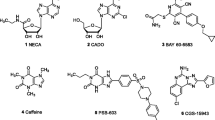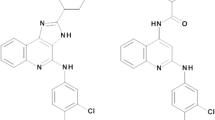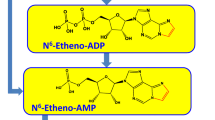Summary
Radioligand binding to A1 adenosine receptors at brain membranes from seven species was investigated. The antagonist 8-cyclopentyl-1,3-[3H]dipropyl-xanthine ([3H]DPCPX) bound with affinities between 0.17 nM in sheep brain and 2.1 nM in guinea pig brain. Competition of several antagonists for [3H]DPCPX binding showed that the most potent compounds were DPCPX with K i values of 0.05 nM in bovine brain and 1.1 nM in guinea pig brain and xanthine amine congener (XAC) with K i values of 0.03 nM in bovine brain and 5.5 nM in guinea pig brain. The differences in affinity of the agonist radioligand 2-chloro-N 6-[3H]cyclopentyl-adenosine ([3H]CCPA) were less pronounced, ranging from a K D value of 0.12 nM (hamster brain) to 0.42 nM (guinea pig brain). Agonist competition for [3H]DPCPX binding of photoaffinity labelling, however, exhibited marked species differences. N-Ethylcarboxamidoa-denosine (NECA) and S-N 6-phenylisopropyladenosine (S-PIA) showed 20 to 25-fold different K D values in different species. NECA had a particularly high affinity in guinea pig brain and was only two-fold less potent than R-PIA. Thus, the difference from the “classical” A1 receptor profile (R-PIA > -NECA > S-PIA) is not sufficient to speculate that A1 receptor subtypes may exist that are coupled to different effector systems. Our data show that these difference can easily be explained by species differences.
Similar content being viewed by others
References
Arend LJ, Burnatowska-Hledin MA, Spielman WS (1988) Adenosine receptor-mediated calcium mobilization in cortical collecting tubule cells. Am J Physiol 255: C581-C588
Belardinelli L, Isenberg G (1983) Isolated atrial myocytes: adenosine and acetylcholine increase potassium conductance. Am J Physiol 244: H734-H737
Bevan JA, Bevan RD, Shreeve SM (1989) Variable receptor affinity hypothesis. FASEB J 3:1696–1704
Brückner R, Fenner A, Meyer W, Nobis T-M, Schmitz W, Scholz H (1985) Cardiac effects of adenosine and adenosine analogs in guinea-pig atrial and ventricular preparations: evidence against a role of cyclic AMP and cyclic GMP. J Pharmacol Exp Ther 234:766–774
Bruns RF, Daly JW, Snyder SH (1980) Adenosine receptors in brain membranes: binding of N 6-cyclohexyl[3H]adenosine and 1,3-diethyl-8[3H]phenylxanthine. Proc Natl Acad Sci USA 77:5547–5551
Ferkany JW, Valentine HL, Stone GA, Williams M (1986) Adenosine A1 receptors in mammalian brain: Species differences in their interactions with agonists and antagonists. Drug Dev Res 9:85–93
Hamilton HW, Ortwine DF, Worth DF, Badger EW, Bristol JA, Bruns RF, Haleen SJ, Steffen RP (1985) Synthesis of xanthines as adenosine antagonists, a practical quantitative structure-activity relationship application. J Med Chem 28:1071–1079
Jacobson KA, Ukena D, Kirk KL, Daly JW (1986) [3H]Xanthine amine congener of 1,3-dipropyl-8-phenylxanthine: an antagonist radioligand for adenosine receptors. Proc Natl Acad Sci USA 83:4089–4093
Jacobson KA, Ukena D, Padgett W, Kirk KL, Daly JW (1987) Molecular probes for extracellular adenosine receptors. Biochem Pharmacol 36:1697–1707
Klotz K-N, Lohse MJ (1986) The glycoprotein nature of A1adenosine receptors. Biochem Biophys Res Commun 140: 406–413
Klotz K-N, Cristalli G, Grifantini M, Vittori S, Lohse MJ (1985) Photoaffinity labeling of A1-adenosine receptors. J Biol Chem 260:14659–14663
Klotz K-N, Lohse MJ, Schwabe U, Cristalli G, Vittori S, Grifantini M (1989) 2-Chloro-N6-[3H]cyclopentyladenosine ([3H]CCPA) — a high affinity radioligand for A1 adenosine receptors. Naunyn-Schmiedeberg's Arch Pharmacol 340: 679–683
Kurachi Y, Nakajiama T, Sugimoto T (1986) On the mechanism of activation of muscarinic K+ channels by adenosine in isolated atrial cells: involvement of GTP-binding proteins. Pflügers Arch 407:264–274
Kurtz A (1987) Adenosine stimulates guanylate cyclase activity in vascular smooth muscle cells. J Biol Chem 262:6296–6300
Leid M, Schimerlik MI, Murray TF (1989) Agonist radioligand interactions with the solubilized porcine atrial A1 adenosine receptor. Mol Pharmacol 35:450–457
Leung E, Johnston CI, Woodcock EA (1986) A comparison between the adenosine receptors mediating adenylate cyclase inhibition and cardiac depression in the guinea pig heart. J Cardiovasc Pharmacol 8:1003–1008
Lohse MJ, Lenschow V, Schwabe U (1984) Interaction of barbiturates with adenosine receptors in rat brain. NaunynSchmiedeberg's Arch Pharmacol 326:69–74
Lohse MJ, Klotz K-N, Schwabe U (1986) Agonist photoaffinity labeling of A1 adenosine receptors: persistent activation reveals spare receptors. Mol Pharmacol 30:403–409
Lohse MJ, Klotz K-N, Lindenborn-Fotinos J, Reddington M, Schwabe U, Olsson RA (1987) 8-Cyclopentyl-1,3-dipropylxanthine (DPCPX) — a selective high affinity antagonist radioligand for A1 adenosine receptors. Naunyn-Schmiedeberg's Arch Pharmacol 336:204–210
Lohse MJ, Klotz K-N, Schwabe U, Cristalli G, Vittori S, Grifantini M (1988a) Pharmacology and biochemistry of adenosine receptors. In: Melchiorre C, Gianella M (eds) Recent advances in receptor chemistry. Elsevier, Amsterdam, pp 107–121
Lohse MJ, Klotz K-N, Schwabe U, Cristalli G, Vittori S, Grifantini M (1988b) 2-Chloro-N6-cyclopentyladenosine: a highly selective agonist at A1 adenosine receptors. Naunyn-Schmiedeberg's Arch Pharmacol 337:687–689
Londos C, Cooper DMF, Wolff J (1980) Subclasses of external adenosine receptors. Proc Nail Acad Sci USA 77:2551–2554
Martens D, Lohse MJ, Rauch B, Schwabe U (1987) Pharmacological characterization of A1 adenosine receptors in isolated rat ventricular myocytes. Naunyn-Schmiedeberg's Arch Pharmacol 336:342–348
Martens D, Lohse MJ, Schwabe U (1988) [3H]-8-Cyclopentyl-1,3-dipropylxanthine binding to A1 adenosine receptors of intact rat ventricular myocytes. Cite Res 63:613–620
McGrath J, Wilson V (1988) α-Adrenoceptor subclassification by classical and response-related methods: same questions, different answers. Trends Pharmacol Sci 9:162–165
Munshi R, Linden J (1989) Co-purification of A1 adenosine receptors and guanine nucleotide-binding proteins from bovine brain. J Biol Chem 264:14853–14859
Murphy KMM, Snyder SH (1982) Heterogeneity of adenosine A1 receptor binding in brain tissue. Mol Pharmacol 22:250–257
Oei HH, Ghai GR, Zoganas HC, Stone GA, Zimmerman MB, Field FP, Williams M (1988) Correlation between binding affinities for brain A1 and A2 receptors of adenosine agonists and antagonists and their effects on heart rate and coronary vascular tone. J Pharmacol Exp Ther 247:882–888
Ribeiro JA, Sebastiao AM (1986) Adenosine receptors and calcium: Basis for proposing a third (A3) adenosine receptor. Prog Neurobiol 26:179–209
Schwabe U, Ukena D, Lohse MJ (1985) Xanthine derivatives as antagonists at A1 and A2 adenosine receptors. Naunyn-Schmiedeberg's Arch Pharmacol 330:212–221
Ströher M, Nanoff C, Schütz W (1989) Differences in the GTP-regulation of membrane-bound and solubilized A1-adenosine receptors. Naunyn-Schmiedeberg's Arch Pharmacol 340:87–92
Tawfik-Schlieper H, Klotz K-N, Kreye VAW, Schwabe U (1989) Characterization of the K+-channel-coupled adenosine receptor in guinea pig atria. Naunyn-Schmiedeberg's Arch Pharmacol 340:684–688
Van Calker D, Müller M, Hamprecht B (1978) Adenosine inhibits the accumulation of cyclic AMP in cultured brain cells. Nature 276:839–841
Von der Leyen H, Schmitz W, Scholz H, Scholz J, Lohse MJ, Schwabe U (1989) Effects of 1,3-dipropyl-8-cyclopentyl-xanthine (DPCPX), a highly selective adenosine receptor antagonist, on force of concentration in guinea-pig atrial and ventricular cardiac preparations. Naunyn-Schmiedeberg's Arch Pharmacol 340:204–209
Author information
Authors and Affiliations
Rights and permissions
About this article
Cite this article
Klotz, KN., Vogt, H. & Tawfik-Schlieper, H. Comparison of A1 adenosine receptors in brain from different species by radioligand binding and photoaffinity labelling. Naunyn-Schmiedeberg's Arch Pharmacol 343, 196–201 (1991). https://doi.org/10.1007/BF00168610
Received:
Accepted:
Issue Date:
DOI: https://doi.org/10.1007/BF00168610




